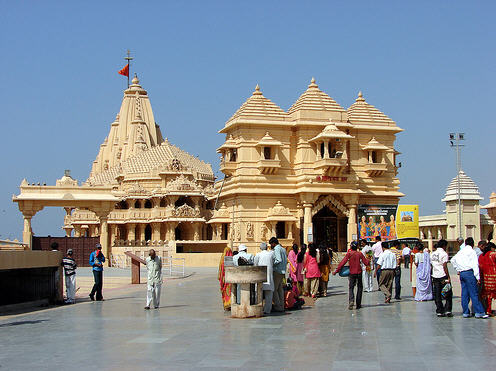
The Someshwar Mahadev temple stands tall among the temples of India. The construction of the present temple in Junagadh district began in 1947. It is the seventh temple built to commemorate the glory of Lord Somnath who is said to have known as Bhairaveshwar in the Satya Yuga, Shravanikeshwar in Treta Yuga and Shrigaleshwar in Dwapar Yuga.
In AD 1026, Mahmud of Ghazni first looted the temple, and then came Afzal Khan, the commander of Ala-ud-din Khilji and later Aurangzeb. It is said that the temple was looted and destroyed as many as seventeen times.
The following extract is from “Wonders of Things Created, and marvels of Things Existing” by Asaru-L- Bilad, a 13th century Arab geographer. It contains the following description of Somnath temple and its destruction: The following is a long quotation:
“Somnath, celebrated city of India, situated on the shore of the sea, and washed by its waves. Among the wonders of that place was the temple in which was placed the deity called Somnath. This deity was in the middle of the temple without anything to support it from below, or to suspend it from above. It was held in the highest honor among the Hindus, and whoever beheld it floating in the air was struck with amazement, whether he was a Musulman or an infidel. The Hindus used to go on pilgrimage to it whenever there was an eclipse of the moon, and more than a hundred thousand would then assemble there. They believed that the souls of men used to meet there after separation from the body, and that the deity used to incorporate them at its pleasure in other bodies, in accordance with their doctrine of transmigration. “The ebb and flow of the tide was considered to be the worship paid to the deity by the sea. The most precious of everything was brought there as offerings, and the temple was endowed with more than 10,000 villages. There is a river (the Ganges) which is held sacred. They used to bring the water of this river to Somnath every day, and wash the temple with it. A thousand brahmins were employed in worshipping the deity and attending on the visitors, and 500 damsels sung and danced at the door–all these were maintained upon the endowments of the temple. The edifice was built upon fifty-six pillars of teak, covered with lead. The shrine of the deity was dark but was lighted by jewelled chandeliers of great value. “When the Sultan Yaminu-d Daula Mahmud Bin Subuktigin went to wage religious war against India, he made great efforts to capture and destroy Somnath, in the hope that the Hindus would then become Muhammadans. He arrived there in the middle of Zi-l k’ada, 416 A.H. (December, 1025 A.D.). “The king looked upon the deity with wonder, and gave orders for the seizing of the spoil, and the appropriation of the treasures. There were many deities of gold and silver and vessels set with jewels, all of which had been sent there by the greatest personages in India. The value of the things found in the temples of the deities exceeded twenty thousand thousand dinars.
(Elliot’s footnote: The enormous treasures found at Somnath have been a theme of wonder for all who have written on that conquest.) “When the king asked his companions what they had to say about the marvel of the deity, and of its staying in the air without prop or support, several maintained that it was upheld by some hidden support. The king directed a person to go and feel all around and above and below it with a spear, which he did, but met with no obstacle. One of the attendants then stated his opinion that the canopy was made of loadstone, and the deity of iron, and that the ingenious builder had skillfully contrived that the magnet should not exercise a greater force on anyone side-hence the deity was suspended in the middle. Some coincided, others differed. Permission was obtained from the Sultan to remove some stones from the top of the canopy to settle the point. When two stones were removed from the summit the deity swerved on one side, when more were taken away it inclined still further, until at last it rested on the ground.”
Restoration of temple after Independence : Before Independence, Prabhas Pattan was part of the Junagarh State, ruled by the Nawab of Junagarh. On the eve of Independence the Nawab announced the accession of Junagarh, which had over 80% Hindu population, to Pakistan. The people of Junagarh rose in revolt and set up a parallel government under Gandhian leader and freedom fighter, Shri Samaldas Gandhi. The Nawab, unable to resist the popular pressure, bowed out and escaped to Pakistan. The provincial government under Samaldas Gandhi formally asked Government of India to take over. The Deputy Prime Minister of India, Sardar Vallabhbhai Patel came to Junagadh on November 12, 1947 to direct the occupation of the state by the Indian army and at the same time ordered the reconstruction of the Somanath temple.
When Sardar Patel, K M Munshi and other leaders of the Congress went to Gandhiji with the proposal of reconstructing the Somnath temple, Gandhiji blessed the move, but suggested that the funds for the construction should be collected from the public and the temple should not be funded by the state. He expressed that he was proud to associate himself to the project of renovation of the temple. But soon both Gandhiji and Sardar Patel died and the task of reconstruction of the temple was now continued under the leadership of K M Munshi, who was the Minister for Food and Civil, supplies in the Nehru Government.
The ruins were pulled down in October 1950 and the mosque was moved to a different location. In May 1951, Rajendra Prasad, the first President of the Republic of India, invited by K M Munshi, performed the installation ceremony for the temple Rajendra Prasad said in his address “The Somnath temple signifies that the power of reconstruction is always greater than the power of destructon”
This episode created a serious rift between the then Prime Minister Jawaharlal Nehru, who saw in movement for reconstruction of the temple an attempt at Hindu revivalism and the President Rajendra Prasad and Union Minister K M Munshi, saw in its reconstruction, the fruits of freedom and the reversal of injustice done to Hindus.
Architecture: The Present temple, Kailash Mahameru Prasada, is built in the Chalukya style of temple architecture and reflects the skill of the Sompuras, Gujarat’s master masons. The temple is situated at such a place that there is no land in between from Somnath seashore to Antarctica. Such an inscription in Sanskrit is found on the ARROW-PILLAR erected on the sea-protection wall at the Somnath Temple. The Darshani Gates of the Golden Temple in Amritsar are the Somnath Temple Gates, which were brought back by the army of the mighty Sikh King Maharaja Ranjit Singh from Afghanistan.


